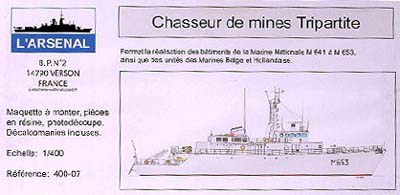
L'Arsenal 1/400 Tripartite
Class Minehunter
Review by Felix Bustelo
During the 1970's, the French, Dutch and Belgian navies collaborated
on the design of a new mine countermeasures vessel. The result of this
effort is the Tripartite Class of minehunters, of which 10 very originally
built for the Marine Nationale, 15 for the Dutch Navy and 9 for the Belgian
Navy. France purchased three Belgian ships and the Pakistani Navy has three
ships in service while the Indonesian Navy has two. During the Gulf War,
Belgium contributed two Tripartite class mine hunters, Iris (M 920) and
Myosotis (M 922) to the Allied mine countermeasures force.
This kit is the latest offering from L'Arsenal and possibly their
most finely cast kit so far. The one-piece full hull and main superstructure
is nearly flawless. My sample did not have a casting block (which is normally
found on full hull resin kits) but some light cleanup and sanding is needed
along the keel. The bilge keels on the bottom sides of the hull are so
wafer thin that you must carefully handle this main part. While examining
and scanning this part for this review, I broke one off and another two
are precariously hanging on. There is a high level of detail, such as watertight
doors, vent grills, and portholes cast into the hull and superstructure.
The Tripartite ships have unique series of, for lack of a better term,
grooves that run up and down parallel along the superstructure. These are
beautifully reproduced in this model. Previous kits from L'Arsenal have
the waterline is faintly etched into the hull, which I find very useful.
For some reason, this kit does not have the waterline demarked. Two resin
stands are provided to hold the model while building and can be used as
actual display stands if you like.
The remaining resin parts are stored in a ziplock bag. These include
the main mast, funnel exhaust cap, crane components, rudders, 20mm gun
and gun platform, rubber dinghies, bollards, the PAP 104 submersibles and
other small parts. The casting of these smaller parts is also excellent
and crisp. Care must be given in removing parts from sprues, especially
the mast components.
The photo-etch parts come in one brass fret. The fret contains 3 lengths
of 3-bar rails, 2 lengths of railing for the rear deck and special railing
for the 20mm gun platform. The fret also contains a variety of details,
such as ladders, main and rudder propellers, machine guns, shields and
platform, fins and trolleys for the PAP 104s, French Navy motto plaques,
Dutch and Belgian ships name plaques and other parts. The detail photoetch
fret has part numbers etched into the brass, which makes identification
very easy and matches the kit instructions. The quality of the photoetch
brass is top rate, with scored bend lines and relief etching.
A decal sheet is included which contains the hull numbers and
names for all ships in this class in service with the French, Belgian and
Dutch navies. For those wishing to model one of the minehunters in service
with the Pakistani and Indonesian navies will have to seek out a separate
source. National flags and ensigns are not provided on the decal sheet.
Also not present on the decal sheet are the bridge windows, which was a
staple in previous kit releases. I liked this feature on the other kit's
decal sheets, as it eliminated the tedious task of painting them in.
The six pages of instructions are very well illustrated and detailed
and are available in English as well as in French. My sample of course
came with the English instructions and they are very good. Background information
on the class, tips and things to do prior to construction, Humbrol and
Tamiya color suggestions and reference sources fill up page one. The next
five pages contain written and illustrated assembly instructions. Some
reference photos are even included with the instruction sheets. I did notice
that on page 4, the illustration for rear deck hoist placement references
the wrong photoetch part; it should say part 28 and not 26. One omission
in the assembly instruction is a diagram showing the how to properly bend
and place photoetch parts 29 and 30, which are the command gangway shields.
You will need to refer photographs to help you with this part. I highly
recommend acquiring issue number 5 (December 2000) of the French magazine
Navires et Histoire, which has an in-depth article on the Tripartite minehunters
with many color photos.
L'Arsenal has another winner with this great kit. I am very, very
tempted to shelve my current project, or at least try to work on both concurrently,
to get started on mine. My thanks to Jacques Druel, of L'Arsenal, for supplying
this review sample.
Click on thumbnail for a full-size picture
|